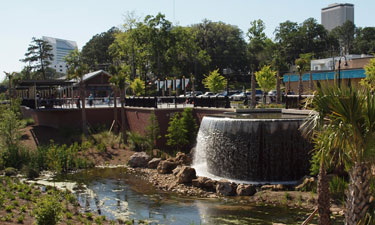 Those living in low-elevation areas of the United States understand the danger of flooding caused by heavy rains, but what about a park that is designed for this very thing? That’s the case for dual-use Cascades Park in Tallahassee, Florida. Called “a stormwater management system disguised as a world-class park,” the 25-acre Cascades Park boasts numerous points of historical significance, including the Prime Meridian Marker, the Smokey Hollow Commemoration and the Korean War Memorial, all within view of Florida’s state capitol. What’s grabbing attention now is the park making its mark as both an area with impressive recreational features and a way to manage excessive rains.
Those living in low-elevation areas of the United States understand the danger of flooding caused by heavy rains, but what about a park that is designed for this very thing? That’s the case for dual-use Cascades Park in Tallahassee, Florida. Called “a stormwater management system disguised as a world-class park,” the 25-acre Cascades Park boasts numerous points of historical significance, including the Prime Meridian Marker, the Smokey Hollow Commemoration and the Korean War Memorial, all within view of Florida’s state capitol. What’s grabbing attention now is the park making its mark as both an area with impressive recreational features and a way to manage excessive rains.
Cascades Park is the center of a new green urban corridor in southeastern Tallahassee. Thanks to engineering and planning firm Genesis, the Capital Cascades Trail Master Plan and Cascades Park plans would address a program for both recreation and stormwater management. The park lies on what is both an EPA Superfund site and industrial area, and is a model for reusing previously abandoned sites. Cascades Park also provides something crucial to this low-lying section of Tallahassee — a source of flood relief. Now, the park contains a drainage area of approximately 1,478 acres.
With the ever-expanding urban setting surrounding Cascades Park, the park plan called for retaining walls for significant stormwater conveyance, reminiscent of the area’s original St. Augustine Branch stream that ran through southeastern Tallahassee, but didn’t allow for as much stormwater transportation. Now, the stormwater management system features not only better conveyance but also a healthy, sustainable stream ecology featuring revegetated stream banks to contribute to the treatment process of the moving water.
Besides the practical use for stormwater management, the park features many other amenities, including winding trails, green infrastructure, an amphitheater, the Cascade Fountain waterfall and pond overlooks, an interactive fountain and water play area, and a Discovery and Adventure Garden featuring nature-oriented activities for children and adults. Cascades Park is not only an effective public works asset to keep people safe from dangerous flood conditions, it is a modern, urban playground for recreation and leisure.
The landscape features are also worth noting. The landscaping was designed to enhance and connect the natural outdoor areas around the park while also arranging shade trees and plant beds so multiple vantage points offer enjoyable views. Besides convenience measures, the park design preserves tree groves that include century-old live oaks as well as planting new and mostly native species. Natural spaces that are significant to Cascade’s heritage are also preserved under the plan.
With multiple benefits for this Florida community — stormwater management, diverse recreation opportunities, conservation and even reuse of the land itself — Cascades Park is a model for green urban facilities that not only embraces modern features but honors the heritage of the land while providing an important safety advantage.
Marissa Bracamonte is the Editorial Intern for Parks & Recreation Magazine.

